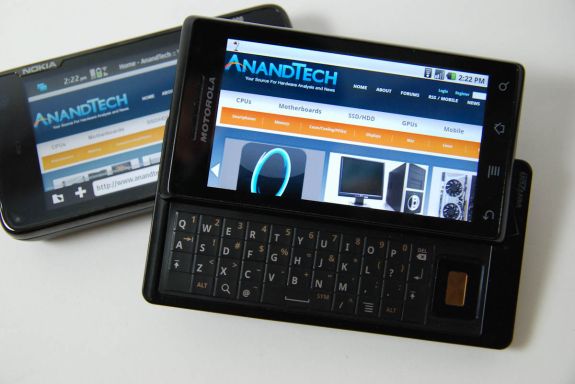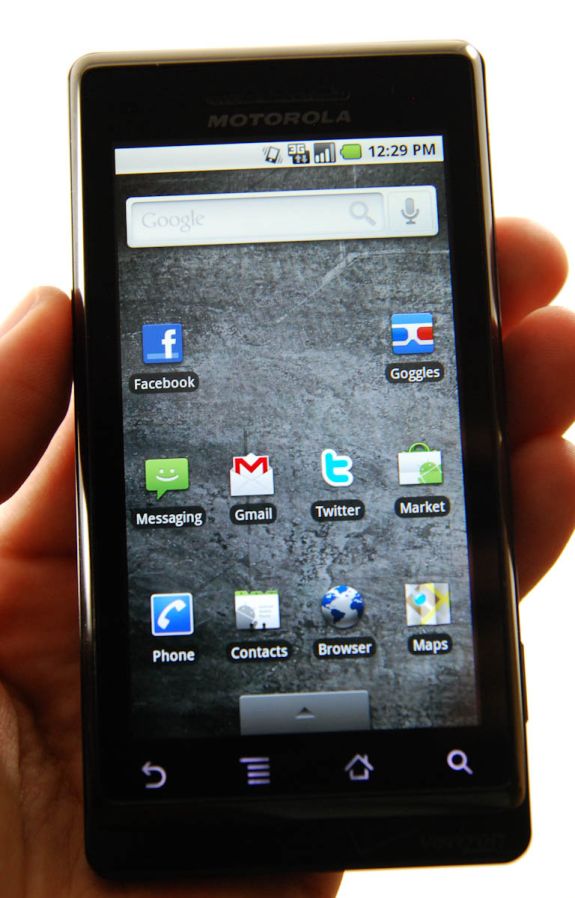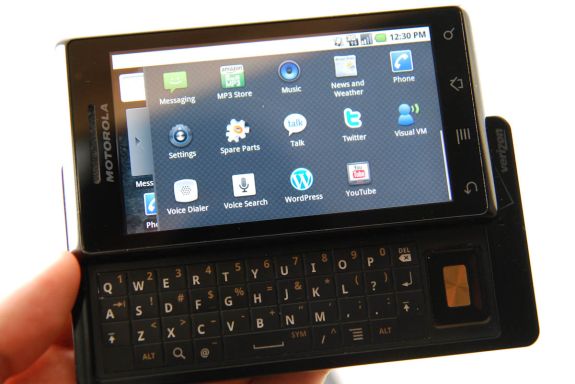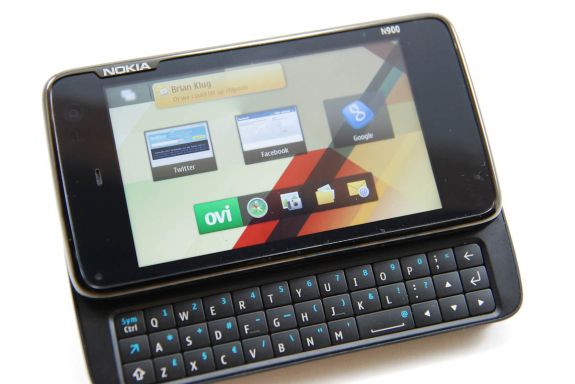Two OMAP 3430 Phones: Nokia N900 and Motorola Droid
by Brian Klug on June 10, 2010 9:29 PM EST- Posted in
- Smartphones
- N900
- Maemo
- Motorola Droid
- Droid
- MeeGo
- Android
- Mobile
The Motorola Droid continues to be the king of Android devices that include a hardware keyboard, and the smartphone which bore the Android flagship crown for some time before the Nexus One. Meanwhile, the Nokia N900 runs Maemo linux 5 - the operating system which - with polish and joint collaboration with intel - will soon emerge as MeeGo and power a host of Moorestown-packing devices. We're doing something a bit irregular by reviewing both phones in one article, but that's again because they're both running on the same Texas Instruments OMAP3 SoC. Let’s dive into both phones and see how they fare.
Motorola Droid - Still Does
As you probably already know, the Motorola Droid marked a turning point for Motorola, for Verizon’s smartphone lineup, and quite possibly a coming of age for Android as the first shipping smartphone with a mature 2.0 release. It wowed the market when it debuted Google Navigation, but puzzled everyone with its initial lack of multitouch support inside all official Google apps - despite packing a full multitouch digitizer.
Since launch, the Moto Droid has and will continue to see continual incremental updates. First, the Android 2.1 update added multitouch to the browser, gallery, and google maps, along with a number of other improvements brought alongside the entire platform update. At Google I/O 2010, we’ve now learned that the Moto Droid will see another update to Android 2.2 before year’s end - bringing a promised 2-5x speed boost to Android’s Dalvik virtual machine with a new JIT compiler, full in-browser Flash 10.1 in addition to Adobe Air support, cloud-to-device push APIs, OS-level WiFi tethering, and browser speed increases among other features.
It’s obvious that despite the recent release of the HTC Incredible, the Moto Droid will continue to hold a place in Verizon’s growing lineup of Android smartphones - and likely at a lower price point than HTC’s new flagship. Currently, Verizon is offering a buy one get one free Motorola Droid promption with purchase and a 2-year contract.
The Droid’s chief differentiating factor (other than likely continued lower price point) is the hardware keyboard. For so many, having a hardware keyboard is still a fundamentally important feature, though virtual keyboards aren’t as bad as they used to be - and they’re getting better. As an aside, it’s amazing how quickly ‘Big Red’ Verizon turned its lineup around and became host to so much Android hardware.
Nokia N900 - a ‘mobile computer’
There’s no doubt about it - the Nokia N900 is a unique beast. In fact, it’s that uniqueness which makes it a difficult sell for all but the most hardcore smartphone consumers, but also potentially the most powerful. The N900 is a landscape QWERTY slider with a 3.5” resistive LCD, front and back facing cameras, 3G HSPA for T-Mobile bands, and runs the debian derivative Maemo 5 OS.
I think it’s a fair argument to make that the N900 hasn’t received as much love state-side as it has abroad, or rightfully deserves. That’s probably due in part to only being sold unlocked with no subsidy, by no specific carrier (though it is targeted at T-Mobile for 3G support, and will work with 2.5G EDGE on AT&T), for $499 at retailers like Amazon. But it isn’t just Nokia grappling with that issue - Google recently learned how hard of a sell unsubsidized, bring your own plan schemes are with its Nexus One. In general, it’s hard to sell people on a $500+ smartphone if they can’t try the device beforehand, or get carrier support.
That aside, the N900 is likely the final evolution in a long chain of internet tablets designed by Nokia - starting with the N770 in 2005. Maemo linux has been as open as open source can be since the very beginning; its application manager started as little more than an APT frontend. If you prefer, it can even still be used that way from the XTerm terminal with an apt-get install. It’s a platform that’s been adorned and worshiped as the ultimate linux smartphone platform by hardcore *nix nerds ever since, and I intend to do it justice.














68 Comments
View All Comments
Wadzii22 - Friday, June 11, 2010 - link
Out of curiosity I ran linpack and Benchmark pi on my droid that's oc'd to 1ghzmy benchmark pi score was 1280 and linpack gives me 17.24 mflops
strikeback03 - Friday, June 11, 2010 - link
Did you run them stock? As those numbers seem to be a ~4x improvement over what is shown here, which seems odd given the ~2x increase in clockspeed.Wadzii22 - Wednesday, June 16, 2010 - link
with the phone completely stock my scores were basically the same as whats in the original article.jamyryals - Friday, June 11, 2010 - link
Please continue this type of in depth comparison with current and future hardware. PC hardware is all well and good, but it's all so fast now the mobile space is a much more interesting battle. Not to mention with how fast things are evolving there is the opportunity for a lot of content.Ratman6161 - Friday, June 11, 2010 - link
For eample, my droid purchased in early April came out of the box running at 600 MHz (though now it actually runs at up to 900 Mhz). My wife got hers in early June and hers is 600 MHz too and also came out of the box with Android 2.1 already on it.Wadzii22 - Friday, June 11, 2010 - link
For whatever reason, setcpu always sees a stock droid's max at 600, but they do run at 550. I just got a new one yesterday after bricking my old droid, it showed the same thing.CharonPDX - Friday, June 11, 2010 - link
Nokia was the originator of the "sell unsubsidized smartphones direct" model, years before Apple or Google. You could get a Nokia N80 at CompUSA completely unlocked for $800 in 2006, a year before the unsubsidized iPhone.Stas - Friday, June 11, 2010 - link
0.1 build with fixed WiFi and maps.LinPack - 12.2 (twelve point two)MFLOPS
Engadget.com loads in 20 sec (default browser)
'nuff said.
Stas - Friday, June 11, 2010 - link
forgot to mention. the CPU is at 800Mhz. I've had it up at 900Mhz with bare Android build (leaked 2.2) and the performance seems no different, but no numbers, sorry.milli - Saturday, June 12, 2010 - link
That's pretty wrong what you're saying there.Qualcomm didn't even license the A8 (nor will they ever).
What they did license is the ARMv7 instruction set (and that's a huge difference). With that they made a custom implementation of the ARMv7 architecture. (BTW Qualcomm already stated in 2005 that they're an architectural licensee for ARM’s ARMv7 instruction set)
There are many differences between Scorpion and A8.
I'll quote from a certain article since i can't say it better:
'Although Scorpion and Cortex-A8 have many similarities, based on the information released by Qualcomm, the two cores differ in a number of interesting ways. For example, while the Scorpion and Cortex-A8 NEON implementations execute the same SIMD-style instructions, Scorpion’s implementation can process128 bits of data in parallel, compared to 64 bits on Cortex-A8. Half of Scorpion’s SIMD data path can be shut down to conserve power. Scorpion’s pipeline is deeper: It has a 13-stage load/store pipeline and two integer pipelines—one of which is 10 stages and can perform simple arithmetic operations (such as adds and subtracts) while the other is 12 stages and can perform both simple and more complex arithmetic, like MACs. Scorpion also has a 23-stage floating-point/SIMD pipeline, and unlike on Cortex-A8, VFPv3 operations are pipelined. Scorpion uses a number of other microarchitectural tweaks that are intended to either boost speed or reduce power consumption. (Scorpion’s architects previously designed low-power, high-performance processors for IBM.) The core supports multiple clock and voltage domains to enable additional power savings."
"Qualcomm claims that Scorpion will have power consumption of roughly 200 mW at 600 MHz (this figure includes leakage current, though its contribution is typically minimal in low-power processes). In comparison, ARM reports on its website that a Cortex-A8 in a 65 nm LP process consumes .59 mW/MHz (excluding leakage), which translates into about 350 mW at 600 MHz."
With that said, i don't understand where the misconception about the Scorpion being an A8 started. Even Qualcomm states clearly on their own website that Scorpion is not licensed from ARM. They also state that they invested hundred of millions in creating their own core based on the ARMv7 instruction set.
I hope now all the staff from Anand will stop saying that there's an A8 inside of Snapdragon. Or maybe you should even clarify that with a small article.